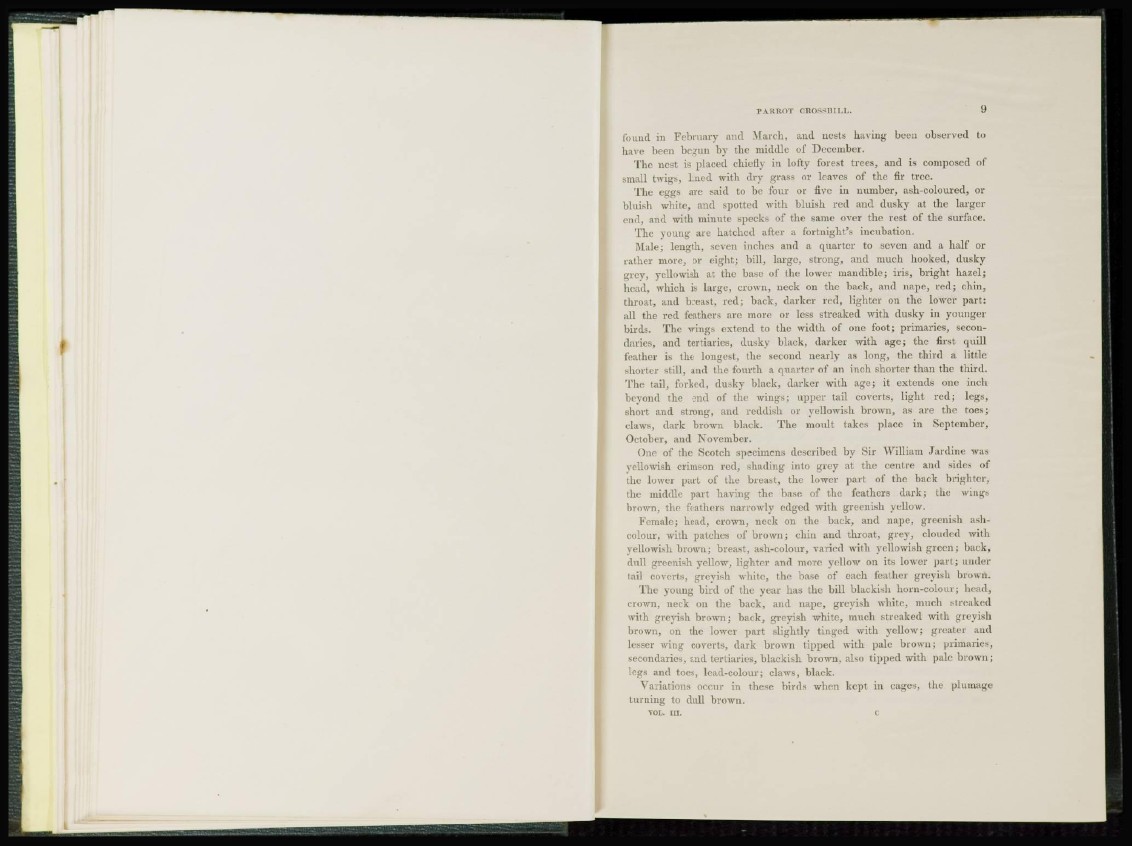
PARROT CROSSBILL. 9
found in February and March, and nests having been observed to
have been begun by the middle of December.
The nest is placed chiefly in lofty forest trees, and is composed of
small twigs, lined with dry grass or leaves of the fir tree.
The eggs are said to be four or five in number, ash-coloured, or
bluish white, and spotted with bluish red and dusky at the larger
end, and with minute specks of the same over the rest of t h e surface.
The young are hatched after a fortnight's incubation.
Male; length, seven inches and a quarter to seven and a half or
rather more, or eight; bill, large, strong, and much hooked, dusky
grey, yellowish at the base of the lower mandible; iris, b r i g h t hazel;
head, which is large, crown, neck on the back, and nape, r e d ; chin,
throat, and breast, red; back, darker red, lighter on the lower part:
all the red feathers arc more or less streaked with dusky in younger
birds. The wings extend to the width of one foot; primaries, secondaries,
and tertiaries, dusky black, darker with age; the first quill
feather is the longest, the second nearly as long, the t h i r d a little
shorter still, and the fourth a q u a r t e r of an inch shorter than the third.
The tail, forked, dusky black, darker with age; it extends one inch
beyond the end of the wings; upper tail coverts, light red; legs,
short and strong, and reddish or yellowish brown, as are the toes;
claws, dark brown black. The moult takes place in September,
October, and November.
One of the Scotch specimens described by Sir William J a r d i n e was
yellowish crimson red, shading into grey at the centre and sides of
the lower part of the breast, the lower part of the back brighter,
t h e middle part having the base of the feathers dark; the wings
brown, the feathers narrowly edged with greenish yellow.
Female; head, crown, neck on the back, and nape, greenish ashcolour,
with patches of b r o w n ; chin and throat, grey, clouded with
yellowish b r o w n ; breast, ash-colour, varied with yellowish g r e e n ; back,
dull greenish yellow, l i g h t e r and more yellow on its lower p a r t ; under
tail coverts, greyish white, the base of each feather greyish brown.
The young bird of the year has the bill blackish horn-colour; head,
crown, neck on the back, and nape, greyish white, much streaked
with greyish brown; back, greyish white, much streaked with greyish
brown, on the lower part slightly tinged with yellow; greater aud
lesser wing coverts, dark brown tipped with pale brown; primaries,
secondaries, and t e r t i a r i e s , b l a c k i s h brown, also t i p p e d with pale brown;
legs and toes, lead-colour; claws, black.
Variations occur in these birds when kept in cages, the plumage
t u r n i n g to dull brown.
VOL. III. c